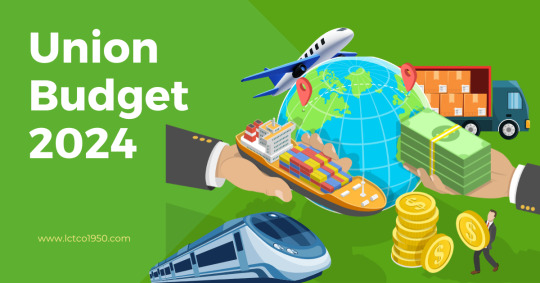#LogisticsReform
Explore tagged Tumblr posts
Text
National Logistics Policy: India's Path to Global Competitiveness Amidst Budget Expectations

As Union Finance Minister Nirmala Sitharaman prepares to present the Budget for 2024-25 in the Lok Sabha on July 23, the nation anticipates significant economic reforms. This Budget, the first major economic document of the Modi 3.0 government, is expected to lay a road map for making India a developed nation by 2047. Amidst expectations for tax relief to boost consumption, measures to curb inflation, and initiatives to accelerate economic growth, the National Logistics Policy (NLP) continues to play a pivotal role in India’s economic transformation.
Understanding the National Logistics Policy
Launched by the Government of India, the National Logistics Policy aims to address inefficiencies in the logistics sector, which have been a bottleneck for economic growth. The sector is currently fragmented, with multiple stakeholders and regulatory challenges leading to high costs and inefficiencies. The NLP seeks to integrate various modes of transport, streamline regulatory processes, and promote the use of technology to create a seamless logistics network.
Budget 2024-25: Expectations and Implications for Logistics and Business
As the Modi government prepares to present its economic vision for the coming fiscal year, several key expectations have emerged:
Tax Relief for the Common Man: Experts have urged the government to provide tax relief to boost consumption, which in turn would drive demand across various sectors, including logistics and manufacturing.
Measures to Curb Inflation: With inflationary pressures affecting both consumers and businesses, the Budget is expected to include measures to stabilize prices, ensuring a more predictable economic environment.
Economic Growth and Job Creation: On July 11, Prime Minister Narendra Modi emphasized a renewed thrust on job creation and a concerted push to manufacturing and rural businesses during a meeting with top economists. This focus is expected to translate into policies that bolster employment opportunities and stimulate economic activity.
Strategic Initiatives under the National Logistics Policy
Reducing Logistics Costs: A primary objective of the NLP is to reduce logistics costs as a percentage of GDP from the current 14-15% to about 8%. This reduction will make Indian goods more competitive in the global market, especially if supported by favorable tax policies.
Enhancing Efficiency: By improving logistics infrastructure and processes, the NLP aims to reduce transit times and costs. The Budget is expected to allocate funds for better road and rail connectivity, efficient warehousing, and the adoption of technology for real-time tracking.
Promoting Multi-Modal Transport: Integrating road, rail, air, and waterways to ensure the most efficient mode of transport is used will be crucial. The Budget may include incentives to promote multi-modal logistics hubs and corridors.
Standardization and Digitization: The NLP promotes the standardization of logistics processes and the use of digital platforms for seamless information flow. The Budget could introduce policies that support the development of a unified logistics interface platform.
Sustainability: The policy emphasizes sustainable logistics practices, encouraging the use of green technologies. The Budget might allocate resources for promoting eco-friendly logistics solutions.
Industry Expectations from the Budget
Ashok Rajpal, Managing Director of Ambrane India , highlighted the industry's expectations: "We look forward to policies that reinforce domestic manufacturing, foster innovation, and enhance our global competitiveness. Financial incentives and simplified regulatory frameworks are crucial for maintaining sector vitality. Additionally, fostering self-sufficiency in advanced technologies will significantly enhance local manufacturing efforts."
Rajpal's statement underscores the importance of the Budget in shaping policies that drive domestic manufacturing and innovation. The logistics sector, being integral to manufacturing and supply chains, stands to benefit significantly from these initiatives.
Impact on the Indian Economy
The National Logistics Policy, supported by a favorable Budget, is expected to have a profound impact on the Indian economy:
Boosting Exports: By reducing logistics costs and improving efficiency, Indian products will become more competitive in the global market, leading to a boost in exports.
Attracting Foreign Investment: Improved logistics infrastructure will attract foreign investment, as global companies seek efficient supply chains for their operations.
Job Creation: The development of logistics parks, modernization of ports, and dedicated freight corridors will create employment opportunities in construction, operations, and maintenance.
Challenges and the Way Forward
Implementing the National Logistics Policy alongside the Budget initiatives will come with challenges. Coordinating between multiple stakeholders, including central and state governments, private players, and regulatory bodies, will be critical. Ensuring timely completion of infrastructure projects and effective use of technology will also be key to the policy's success.
To overcome these challenges, the government needs to adopt a collaborative approach, engaging with stakeholders at every level. Continuous monitoring and evaluation of the policy's impact will be essential to make necessary adjustments and improvements. Promoting awareness and understanding of the policy among businesses and the general public will be crucial for its successful implementation.
Conclusion
As the nation awaits the presentation of the Budget for 2024-25, the National Logistics Policy remains a cornerstone of India’s economic strategy. The policy's focus on reducing costs, improving efficiency, and promoting sustainable practices aligns with the broader economic goals of the Modi 3.0 government. The successful implementation of the NLP, supported by the Budget’s favorable measures, will be instrumental in realizing India's vision of becoming a $5 trillion economy and a developed nation by 2047.
#NationalLogisticsPolicy#Budget2024#IndiaBudget#EconomicGrowth#Modi3Government#India2024#LogisticsReform#GlobalCompetitiveness#ManufacturingInIndia#IndianEconomy#TaxRelief#InnovationIndia#InfrastructureDevelopment#SustainableLogistics#JobCreation#MakeInIndia#LogisticsEfficiency#EconomicReforms#SupplyChainIndia#FutureOfIndia
0 notes